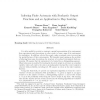Free Online Productivity Tools
i2Speak
i2Symbol
i2OCR
iTex2Img
iWeb2Print
iWeb2Shot
i2Type
iPdf2Split
iPdf2Merge
i2Bopomofo
i2Arabic
i2Style
i2Image
i2PDF
iLatex2Rtf
Sci2ools
AAAI
1992
1992
Inferring Finite Automata with Stochastic Output Functions and an Application to Map Learning
It is often useful for a robot to construct a spatial representation of its environment from experiments and observations, in other words, to learn a map of its environment by exploration. In addition, robots, like people, make occasional errors in perceiving the spatial features of their environments. We formulate map learning as the problem of inferring from noisy observations the structure of a reduced deterministic nite automaton. We assume that the automaton to be learned has a distinguishing sequence. Observation noise is modeled by treating the observed output at each state as a random variable, where each visit to the state is an independent trial and the correct output is observed with probability exceeding 1=2. We assume no errors in the state transition function. Using this framework, we provide an exploration algorithm to learn the correct structure of such an automaton with probability 1 ; , given as inputs , an upper bound m on the number of states, a distinguishing sequ...
AAAI 1992 | Correct Output | Deterministic Nite Automaton | Distinguishing Sequence | Intelligent Agents |
| Added | 06 Nov 2010 |
| Updated | 06 Nov 2010 |
| Type | Conference |
| Year | 1992 |
| Where | AAAI |
| Authors | Thomas Dean, Dana Angluin, Kenneth Basye, Sean P. Engelson, Leslie Pack Kaelbling, Evangelos Kokkevis, Oded Maron |
Comments (0)

